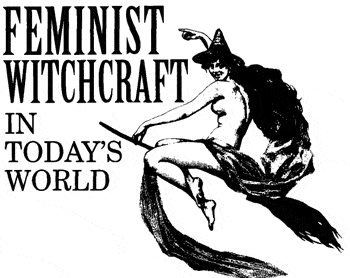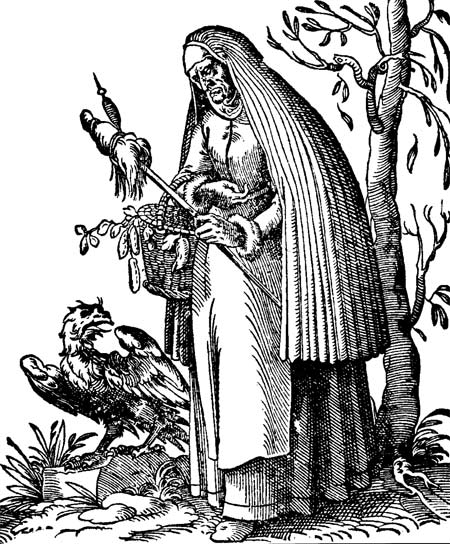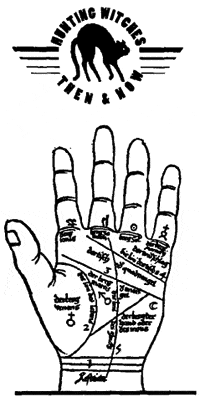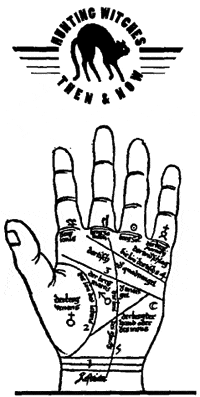by Ann Forfreedom
What is modern witchcraft, and why is a specifically feminist witchcraft needed?

Many people who consider themselves to be contemporary “witches” or “pagans” feel they are reviving a millennia-old spirituality. Some harken back to cultures that worshipped Goddesses as well as Gods, and were led by priestesses and wise elder women. Others see their origins in paleolithic ceremonial magical groups. Some identify with “New Age” thinking; many do not use that label. It is generally believed that all witches are pagan (in worldview), but not all pagans are witches. (For more details, see Drawing Down the Moon, by Margot Adler, revised edition.)
As a religion, witchcraft focuses on working with nature, on psychic development and on direct personal relationships with Deity (Goddesses, or Goddess and God). It emphasizes balance, learning, and responsibility. As a pre-Christian, Goddess-oriented religion, witchcraft encourages female leadership, and many of its practioners are feminist or sympathetic to feminism.
Witchcraft is often called by its older Anglo-Saxon names: wicce or wicca. The Old English neutral plural for witches is wiccan, although some witches today say “wiccans.” Although the masculine term wicca is most often used (which I consider symptomatic of the internal sexism of modern witchcraft), the Anglo-Saxon Old English term for the religion, and the term I use, is wiccecraeft.
A Real Wise Woman Challenges The Stereotypes and reveals the on-going persecution of “Witches”
Witchcraft is sometimes viewed as being “evil.” This mentality fueled the witch-hunting inquisitions centuries ago, and is responsible for attacks against real witches and powerful women around the world today.
For instance, in 1985, three women in Zimbabwe were shot and killed by a group of men who accused them of being witches.
At least 20 women in West Bengal, India were killed as suspected witches in 1987. In 1989, women in eastern India were murdered after they were accused of being witches and casting “evil spells;” one of them was dragged from her hut, tied to a tree and slaughtered with an ax by two male neighbors, only one of whom was apprehended by police.
In 1990, in Venda – the nominally independent Black homeland set up by South Africa – an angry crowd set fire to an inhabited home, fatally burning two infants, because they believed the parents were involved in witchcraft.
By the late 1980s, witchcraft was a crime in several nations. In 1987, the West African nation of Benin declared that practicing witchcraft or magic was punishable by death or 10 to 20 years hard labor. The South American nation of Ecuador banned witches, fortune tellers and natural healers in 1989. Beginning in the mid-1980s, right-wing groups in the United States attacked “witchcraft” in an attempt to disrupt and control the public right to freedom of expression.
In 1985, parents’ groups in at least 20 states, under the leadership of right-wing anti- feminist leader Phyllis Schlafly, demanded that public schools get parents’ written permission for classroom discussions and curriculum material on a variety of topics, including witchcraft, abortion, social roles of men and women, homosexuality, human sexuality, and Eastern mysticism. A lawsuit filed by one such group, Citizens Organized for Better Schools’ (Mozart v. Hawkins County School System), charged that an elementary reading series published by Holt, Rinehart & Winston was teaching witchcraft, situation ethics, disrespect for parental authority, evolution and secular humanism.
More recent attacks have included Nathaniel Hawthorne’s classic novel, The Scarlet Letter, for dealing with witchcraft and religion, and Frank Baum’s timeless fantasy, The Wizard of Oz, for presenting a positive witch (Glinda the Good).
Also in 1985, newspaper and TV reports on child abuse and possible murder cases started using the terms “witchcraft,” “occult,” and “Satanism” almost interchangeably.
In August of that year, Rep. Robert Walker (R-PA) introduced an act to remove tax-exempt status from religious groups based on witchcraft, which indicated that a real witch hunt was developing. Then, Sen. Jesse Helms (R-NC), a powerful right- wing politician linked to ultrafundamentalist Christianity and censorship, got involved.

Helms introduced Amendment 705 to the fiscal 1986 Treasury and Post Office appropriations bill, HR 3036 in September 1985. Helms’ amendment, which specified, “No funds appropriated under this Act shall be used to grant, maintain, or allow tax exemption to any cult, organization, or other group that has as a purpose, or that has any interest in, the promoting of satanism or witchcraft,” was passed by voice vote, without dissent or debate in the Senate. “Witchcraft” was defined by Helms as “the use of powers derived from evil spirits, the use of sorcery, or the use of supernatural powers with malicious intent.”
Helms’ amendment was meant to cut off tax and postal privileges for any group that he disfavored by fitting them within the vague definitions of the amendment. Both the American Civil Liberties Union (A.C.L.U.) and the Internal Revenue Service (I.R.S.) opposed the amendment, and the A.C.L.U. argued against the government’s ability to define which religions are considered legitimate.
After a barrage of protests by witches and non-witches alike, the House-Senate conferees quietly dropped the amendment “on a technicality.”
Historically, witch hunters have attacked not only unconventional religions, but independent, powerful, and publicly visible women.
A modern witch hunt of this type occurred recently in Beulah, North Dakota, when two men plotted to murder 61-year-old Karina Singer because neighbors thought she was a dangerous “witch.”
This case was reminiscent of witch hunting over several centuries.
Karina Singer had lived in the area for %\ years. She and her husband John were farm owners who wanted to turn their farm into what Singer termed “a place of beauty and peace,” where friends could visit for extended vacations.
In fall, 1989, the couple laid down two Native American “medicine wheels,” or rock configurations, “for the healing of the land.” John died of cancer the following April, but Karina continued the work. She had a guest house built and a pit burned in the yard.
When Singer had two other women visit the farm in the summer of 1990, she was unaware that rumors about her had been circulating for years. As Mercer County State’s Attorney Alan Duppler later reported, “There have been rumors flying around Mercer County that these three ladies are witches and they’re sacrificing animals and doing general cult type things.” According to the story, the guest house was a church, and visitors were seen dancing around a pit fire. (The “dancers” were apparently construction workers putting out grass fires started by sparks from the newly burned pit in the yard.)
When Jim Reppen, who worked for a tire service company, and Dean Unterseher, a farmer, heard the story, they “decided they were going to go down and eliminate the problem,” says Duppler. Reppen and Unterseher, both armed, were arrested on Singer’s farm in August and charged with conspiring to murder her.
“I’m stunned my neighbors could believe these things when we lived here 21 years,” Singer said. “And instead of calling me to find out if they were true, they circulated them around until they became like an atomic blast mushrooming out of the prairie.”
Karina Singer was an independent landowner, with different spiritual interests from those of her neighbors. She is one of many women – including feminist politicians – who are faced with modern-day witch hunting.
In reality, witchcraft is far from negative or evil. My definition of “witch” is a priestess or priest of wiccecraeft skilled in healing and psychic work and occult magic: A person able to bend or reshape universal energies, or an independent, uppity, powerful, or daring woman.
I define a “feminist” as a female or male who is female-centered or female-oriented; or a person who is not prejudiced against others because of their gender or sexual preferences; or anyone who, in a patriarchal society, works toward the political, economic, spiritual, sexual, and social equality of women.
Modern witchcraft includes a variety of denominations, or “traditions.” The most feminist of these is the Dianic tradition, named for the Roman Goddess Diana, woodland Goddess of Freedom, huntress, and patroness of witches. One branch of Dianic witchcraft includes women and men as practitioners, and honors the God (of Nature, Love, etc.) as well as the Great Goddess. Another branch is lesbian and separatist, refusing to acknowledge males either as practitioners or in the form of Diety (which may be considered reverse sexism).
Some witchcraft denominations often have female leaders and, to an extent, honor the Goddess. But others practice antiwomen sexism, and few witchcraft practitioners of any denomination are overtly involved in feminist issues (though a portion are in peace or ecology groups).
During the past two decades, American feminists have changed much of the outward look of witchcraft. There are more female leaders visible, and there is a great deal more emphasis on Goddess culture. But, despite the long human heritage of Goddess worship around the world, and despite the reality that European witch hunts that lasted for centuries were primarily directed against women, contemporary witchcraft includes and accepts sexists, people who have conducted internal witch hunts, and other kinds of bigots. And witchcraft too often tends to speak in male terms, to assume a greater importance for male deities and male spokespeople, and to assume antifeminist or antigay rights stances.

Feminists involved in witchcraft have made a difference, however. The foundation of witchcraft is rooted in female power and female concerns. Much can be learned from feminist witchcraft that one can find useful as a feminist. Because Dianic witchcraft emphasizes the perception of universal creativity and energy as feminine, as the Goddess, women are thereby empowered as vital and important beings in the universe. So, it becomes natural to assume that: Women are creative in all ways; women are leaders; women have a deciding voice in all that matters to them; women are responsible for their actions; women are able to communicate directly with Deity (or universal energy or Nature); and women have sexual freedom, reproductive rights, and the right to define their bodily lives.
Feminist witchcraft encourages the development of intuition as an effective part of human life. Each human being has intuition, an inner voice, a way of deciding quickly what is right or wrong for oneself, and what to do about it. Western culture denies the intuitive judgment, and favors a rational, logical, statistical, or factual approach. Both intuition and logic are necessary for a well-balanced life. My intuition has helped me stay out of potentially dangerous situations, has led me to teach myself to meditate and to learn something about Yoga and T’ai Chi.
Feminist witchcraft also offers positive ways to view and change body images. Witches believe in self-blessings. Each of us is seen as being part of divine energy, of the Goddess and the God. And every part and process of the human body is considered sacred. So, one way to pray to the Goddess/God is to bless one’s self and the basic parts of one’s body.
As I have learned to trust myself and appreciate my body more, I have come to respect the functions of my body. In blessing my body, I learned that my flesh is really alive, composed of living cells that do respond to my needs.
I also learned to bless the coming and going of my monthly period of blood by honoring the Goddess in myself: “She who bleeds, yet does not die.”
Feminist witchcraft focuses on the cyclical patterns of our lives: The moon, the sun, other stars, and the universe. As I became more aware of my personal patterns, I grew more tolerant of my need for solitude, for writing, and for periods of fervent feminist political activity and meetings. I learned to balance more evenly the processes of giving and accepting love. And I learned to do something I thought impossible – to perceive the artist in myself. Cultural creativity – work educated to the Muses and Pan – is encouraged in feminist witchcraft.
Witches are very interested in herbal knowl-1 edge and in learning to heal oneself, others, even the earth. And many witches are in various kinds of healing professions or vocations.
Witches generally believe in reincarnation, in a cycle of life after life filled with learning. As I learned to see my life as one of a number of lifetimes, I also learned not to be afraid of death. I now see death as brother to the Goddess of Life and Love (as in the myth of Ishtar and the Lord of Death), or death as the sister-self of the Goddess-on-Earth (as in the Egyptian view of Nephthys below and Isis above, or the Greek views of Persephone underground and Demeter aboveground).
The knowledge of healing methods can include not only ways to make life easier and healthier, but also ways to ease the passing of life into death. Sometimes death is a peaceful passage from one stage of existence to another. In 1970, my 30-year-old brother died of cancer. I priestessed him – counseling him, sending him energy, advising him, sharing with him the psychic experiences that often occur to the dying person. I aided my brother to face death as a journey, neither frightening nor extraordinary. I discovered that many Americans don’t know how to deal with dying and death. Though many nurses are aware of the needs of a dying person and try hard to help, most of the doctors I contacted were unwilling or unable to deal personally with dying patients. The process of dying is made much more painful than it need be for many people in hospitals in this country.
When I perceive death as brother to the Goddess, I feel He is kind to Her daughters, and understanding, and helpful to all who need to pass on to her levels of being. When I personify death as sister to the Goddess, I feel she welcomes her children and renews us, readies us for rebirth, and helps us learn in harmony and peace. We are always moving from living towards dying and beyond, as trees and flowers in nature move through stages of existence and seeming (but only temporary) nonexistence.
Feminist witchcraft offers the feminist movement other helpful theological or philosophical perceptions of life: The process you use is as important as, or even more important than, your goal; balance is important in the ways we live; the energy you send out will return to you at least threefold (whether the energy is in thought or deed); learn to perceive the cycles of events (for example, the Equal Rights Amendment will not die, but efforts to place it into law go through cycles that wane and then wax forth); and human beings need the mystery and security of identifying with Mother Nature or Mother Earth.
Although modern witchcraft reflects some of the basic societal ills of our time, and although many witches today do not practice all they preach, there is much that feminist witchcraft offers to feminists and the feminist movement. If you are drawn to it, be careful and don’t check your principles or your feminism at the gate. For those not so inclined, there is still much to be learned from witchcraft about ourselves and our place in nature.

| STEFANAKIS’ SALEM STATUE: WHAT WENT WRONG? From 1988 through 1991, The Wise Woman publicized and carried ads for the Salem Witch Trial Memorial statue by artist Yiannis Stefanakis. The statue consists of three female figures, representing three sisters – Sarah Cloyce, Mary Esty, and Rebecca Nurse – who were persecuted during the Salem witch trials. (Mary Esty and Rebecca Nurse were executed.) The statue (with two accompanying plaques) was proposed by the artist and a non-profit corporation, the Witch Trial Memorial Fund, as a dignified memorial to the mostly women victims of the Salem witch trials, and of witch hunts everywhere. I have given money and publicity to the statue, which needs bronzing and a permanent site. I went even further in helping what I considered a worthy feminist cause. By October, 1991, 1 was very active in coordinating fundraising and publicity for this project. But three months of intensive, and often successful, work showed me that the problems faced by this project are deeper than the lack of money or a permanent site. I found resistance to the project among Salem area residents. I found that the figures I had been given for the costs of bronzing were inaccurate. Most dangerous of all, I found that the creator and major decision-maker of this project, Yiannis Stefanakis, is a man who undermines his own project and does not keep important commitments. On January 2, 1992,1 withdrew as the main fundraiser for the Salem Witch Trial Memorial statue, and the Institute for Feminist Studies, of which I am the Executive Director, ceased its support of the project. I apologize to all the supportive donors, volunteer publicists and enthusiastic publications that became involved with Stefanakis’ Salem statue because they trusted my word. – A.F. |

Ann Forfreedom, a feminist witch, is the publisher of The Wise Woman feminist journal, Executive Director of the Institute for Feminist Studies, and a lecturer on women’s history, feminist issues, and feminist witchcraft. This article was originally published in On the Issues, Vol. VIII, 1987, and has been updated and revised.
